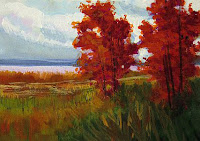Because of conflicting room availability at the church where I hold classes, I've had to revise our class schedule. Below is the new plan. I certainly hope you'll join me! Please contact me now to reserve your space.
June 9--Paint the Summer Sky and Clouds
Our summertime skies are spectacular, with layers of beautiful clouds, summer thunderstorms, and beautiful virga falling. We'll discuss how to paint various kinds of clouds, looking at the structure, color, contrasts and 'rules' of clouds in the daytime summer sky. Any medium is welcome. (At Paradise Methodist Church, 11:30- 2:30.)
Our summertime skies are spectacular, with layers of beautiful clouds, summer thunderstorms, and beautiful virga falling. We'll discuss how to paint various kinds of clouds, looking at the structure, color, contrasts and 'rules' of clouds in the daytime summer sky. Any medium is welcome. (At Paradise Methodist Church, 11:30- 2:30.)
June 16—Gouache Basics
Gouache is opaque watercolor and has all the positive characteristics of watercolor and pastel. Like pastel, you can work from the darks and add the light colors over the top, as well as correcting as many times as you need to, and as in watercolor you can work wet into wet, use washes and various other techniques. I'll teach the basics at this small class. We'll work from photograph, share the same color paints, play around with different brushes, and just find out what this fun and versatile medium can do. I'll provide two different kinds of paper, and the paint and brushes for an extra cost of $10, or you may bring your own. You'll need a small palette of some kind, such as a white dish or plate, or a plastic watercolor palette, and a small jar for water. This class is limited to five students. Reservation required. (At my home in Taylor Ranch 11:30- 2:30, bring a sack lunch.)
Gouache is opaque watercolor and has all the positive characteristics of watercolor and pastel. Like pastel, you can work from the darks and add the light colors over the top, as well as correcting as many times as you need to, and as in watercolor you can work wet into wet, use washes and various other techniques. I'll teach the basics at this small class. We'll work from photograph, share the same color paints, play around with different brushes, and just find out what this fun and versatile medium can do. I'll provide two different kinds of paper, and the paint and brushes for an extra cost of $10, or you may bring your own. You'll need a small palette of some kind, such as a white dish or plate, or a plastic watercolor palette, and a small jar for water. This class is limited to five students. Reservation required. (At my home in Taylor Ranch 11:30- 2:30, bring a sack lunch.)
June 23—How to use Photoshop for Paintings
I'll show you how I use Photoshop to prepare photographs to use for paintings. I use Photoshop Elements 2.0, but the tools I utilize are commonly available in Photoshop, no matter the version, so you should be able to adapt what I do. The space available at my computer is quite small, so we're limited to only five students. Reservation required. (* At my home in Taylor Ranch 11:30- 2:30, bring a sack lunch.)
FULL
June 30—Paint the Night Sky
We'll explore painting the landscape at night, with a closer look at the night sky. I'll challenge you to cobble together two or more photos to create a nighttime landscape with a dramatic sky, perhaps including clouds, the moon or stars. Any medium is welcome. (At Paradise Methodist Church, 11:30- 2:30.)
July 14—How to use Photoshop for Paintings
I'll show you how I use Photoshop to prepare photographs to use for paintings. I use Photoshop Elements 2.0, but the tools I utilize are commonly available in Photoshop, no matter the version, so you should be able to adapt what I do. The space available at my computer is quite small, so we're limited to only five students. Reservation required. (* At my home in Taylor Ranch 11:30- 2:30, bring a sack lunch.)
FULL
I'll show you how I use Photoshop to prepare photographs to use for paintings. I use Photoshop Elements 2.0, but the tools I utilize are commonly available in Photoshop, no matter the version, so you should be able to adapt what I do. The space available at my computer is quite small, so we're limited to only five students. Reservation required. (* At my home in Taylor Ranch 11:30- 2:30, bring a sack lunch.)
FULL
________________________________________________
Class Policies
Class Policies
The cost is $25.00 per class, payable at the door. I greatly appreciate it if you contact me to let me know you're coming. Occasionally, if the class is quite small, the location may be changed.












